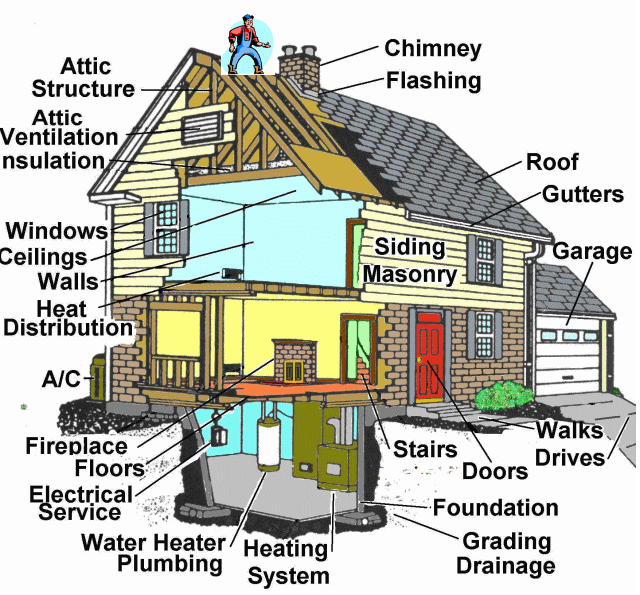INSPECTION SERVICES
The Home Inspection
Home Inspection is supposed to give you peace of mind, but often has the opposite effect. You will be asked to absorb a lot of information in a short time. This often includes a written report, checklist, environmental reports, and what the inspector himself says during the inspection. All this, combined with the Seller’s Disclosure and what you notice yourself, makes the experience even more overwhelming. What should you do?
Relax. Most of your inspection will be maintenance recommendations, life expectancies and minor imperfections. These are nice to know about. However, the issues that really matter will fall into four categories:
1. Major defects. An example of this would be a structural failure.
2. Things that lead to major defects. A small roof-flashing leak, for example.
3. Things that may hinder your ability to finance, legally occupy or insure the home.
4. Safety hazards, such as an exposed, live buss bar at the electrical panel.
Anything in these categories should be addressed. Often a serious problem can be corrected inexpensively to protect both life and property (especially in categories 2 and 4, above).
Most sellers are honest and are often surprised to learn of defects uncovered during an inspection. Realize that sellers are under no obligation to repair everything mentioned in the report. No home is perfect. Keep things in perspective and remember it is inappropriate to demand that a seller address deferred maintenance or conditions already listed on the Seller’s Disclosure.
The passage above is an excerpt from, "Sell Your Home for More", by Nick Gromicko, and I feel it well sets the stage for the discussion that follows.
The HPI Home Inspection is designed with your interests in mind. Items that you want or need to know about are listed in an orderly and easy to follow report format. Conditions as well as recommendations are given as each category is addressed.
Listed below you will find some of the home’s components that are reviewed and commented on in the Home Inspection Report.
EXTERIOR
• Roof covering, gutters and downspouts
Roof covering, gutters and downspouts
• Chimney and vents
Chimney and vents
• Electrical service and meter box
Electrical service and meter box
• Walls, siding materials, windows and doors
Walls, siding materials, windows and doors
• Decks, walks, steps, driveway and garage
Decks, walks, steps, driveway and garage
• Retaining walls, general lot grading and drainage
Retaining walls, general lot grading and drainage
INTERIOR
• Attic, roof decking and exhaust fan operation
Attic, roof decking and exhaust fan operation
• General condition of visible insulation
General condition of visible insulation
• Ceilings, walls, floors, doors and stairs
Ceilings, walls, floors, doors and stairs
• Fireplace hearth and damper door function
Fireplace hearth and damper door function
• Bathrooms and laundry
Bathrooms and laundry
• Kitchen and its major appliances
Kitchen and its major appliances
• Basement and foundation walls
Basement and foundation walls
• Electrical main panel box and shutoff
Electrical main panel box and shutoff
• Visible electrical distribution wiring
Visible electrical distribution wiring
• Visible plumbing: both supply and waste lines
Visible plumbing: both supply and waste lines
• Faucets and fixtures
Faucets and fixtures
• Water service entry and shutoff
Water service entry and shutoff
• Drainage sump pumps
Drainage sump pumps
• Heating system and heat distribution general condition
Heating system and heat distribution general condition
• Water heating system general condition
Water heating system general condition
• Central cooling system and duct work general condition
Central cooling system and duct work general condition
• Common safety devices which include
Common safety devices which include
-Ground fault circuit interrupters (GFCIs)
-Smoke detectors
-Carbon monoxide detectors
-Sprinklers
-Automatic shutoff devices
The items presented above along with others listed in the report will allow you to view the property as a complete picture. This report will not only serve you during the purchase but can be used for years to come as a guide to maintaining your new home.
During the inspection, if you’ve chosen to attend, you will have the chance to be briefed on what was observed. At this time you can ask any questions and discuss service and maintenance schedules for the various items reported on. I strongly encourage you to be present while the inspection is taking place. Viewing the home at the same time as the inspector allows for an invaluable chance to gain an understanding of how the home’s systems function.
The comfort and peace of mind gained from knowing how your home’s major components operate and interrelate with each other is well worth the price paid for an HPI Home Inspection. You’ll be moving into a new house with the confidence you need to make it feel like you’re coming home.
A full written report enclosed in a 3-ring binder with pertinent accessory publications will be provided. The report as a "PDF" format file will be available online within 24-48 hours. Special arrangements can be made if the report is needed sooner.
Please Note: To properly inspect the home's components the utilities/services must be turned on. Such items as shutoff valves, pilot lights, electric circuit breakers/fuses and oil/propane tanks must be in the on position and/or have fuel available for use. Home Inspectors are not authorized to turn these utilities on or off. Please make arrangements to confirm the utilities are on before the day of your inspection.
As an extra note: Results for some of the optional tests, such as radon, water quality, asbestos and others, will take a few days to receive from each of the various laboratories.
PHONE: 860-849-1435
A








